![]()
![]()
![]()
Use LEFT and RIGHT arrow keys to navigate between flashcards;
Use UP and DOWN arrow keys to flip the card;
H to show hint;
A reads text to speech;
97 Cards in this Set
- Front
- Back
- 3rd side (hint)
|
_____ is a layer of adipose tissue deep to the skin. |
Hypodermis. |
|
|
|
_______ is a portion of the epidermis that dips down into the dermis from which new hair grows. |
Hair follicle. |
|
|
|
The _______ is an outer, protective layer of the skin composed of stratified squamous keratinized epithelial tissue. |
Epidermis. |
|
|
|
The ______ is the deeper layer of skin composed of loose connective tissue and dense irregular collagenous connective tissue. |
Dermis. |
|
|
|
_______ are hard, keratinized cells that cover and protect the distal parts of fingers and bones. |
Nails. |
|
|
|
List the layers of the epidermis in thick skin from superficial to deep. |
(1) Stratum corneum. (2) Stratum lucidum. (3) Stratum granulosum. (4) Stratum spinosum. (5) Stratum basale. |
|
|
|
Eccrine sweat is released into a _____, and sebum is released into a _____. |
Duct; Hair follicle. |
|
|
|
The primary protein produced by the main call type in skin is ______. |
Keratin. |
|
|
|
True or false: mitotic cells in a nail are found in the eponychium. |
False. |
|
|
|
What layer of the epidermis contains melanocytes? |
The stratum basale. |
|
|
|
Which epidermal layer is only found in thick skin? |
Stratum lucidum. |
Think: hands and soles of feet. |
|
|
The _____ functions in light touch, texture discrimination and are found in the stratum basale? |
Merkel cells. (Tactile discs.) |
|
|
|
True or false: Apocrine sweat glands are found in the auxiliary and genital regions. |
True. |
|
|
|
The extracellular matrix (ECM) consists of ____ and ____. |
Ground substance; Protein fibers. |
|
|
|
__________ is a gelatinous material that contains water, ions, nutrients, and large polysaccharides. |
Ground substance. |
|
|
|
List the three types of protein fibers found within ground substance. |
Collagen fibers, elastic fibers, and reticular fibers. |
|
|
|
_______ consists of a single layer of flat cells with a centrally located, flattened nucleus. |
Simple squamous epithelium. |
|
|
|
We often find ________ in places where substances have to cross the epithelium quickly, such as the air sacs of the lungs. |
Simple squamous epithelium. |
|
|
|
The cells of _______ are short and have a spherical, central nucleus. |
Simple cuboidal epithelium. |
|
|
|
________ is found lining glands such as the thyroid gland, certain respiratory passages, and in the kidneys. |
Simple cuboidal epithelium. |
|
|
|
The cells of ________ have spherical nuclei generally located near the base of the cell. |
Simple columnar epithelium. |
|
|
|
_______ line certain respiratory passages and much of the digestive tract. |
Simple columnar epithelium. |
|
|
|
__________ looks as if it has many cell layer but actually has only one layer of cells. The nucleus of the cells are at different heights, giving the epithelium the appearance of having many layers. This type of epithelium usually has cilia. |
Pseudostratified ciliated columnar epithelium. |
|
|
|
__________ looks as if it has many cell layer but actually has only one layer of cells. The nucleus of the cells are at different heights, giving the epithelium the appearance of having many layers. This type of epithelium usually has cilia. |
Pseudostratified ciliated columnar epithelium. |
|
|
|
______ is found lining the nasal cavity and much of the respiratory tract. |
Pseudostratified ciliated columnar epithelium. |
|
|
|
______ consists of many layers of flattened cells and has two variants. |
Stratified squamous epithelium. |
|
|
|
_______ are found in the superficial layer of the skin where the body is subject to multiple environmental stresses (keratinized), and is also located in places subject to lesser degrees of mechanical stress such as the vagina, oral cavity, pharynx, and anus (non keratinized). |
Stratified squamous epithelium. |
|
|
|
_______ & _______ are found lining the ducts of certain glands. |
Stratified cuboidal epithelium; Stratified columnar epithelium. |
|
|
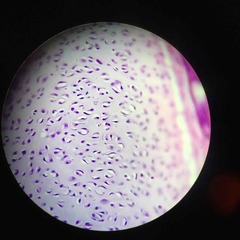
What tissue is this? |

Hyaline cartilage. |
|
|
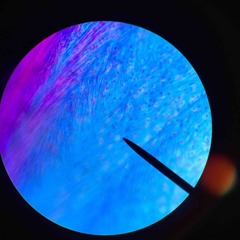
What tissue is this? |
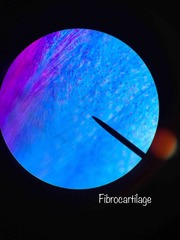
Fibrocartilage. |
|
|
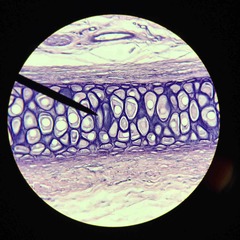
What tissue is this? |

Elastic cartilage. |
|
|
|
List the “proper” connective tissues. |
Loose areolar CT. Reticular CT. Adipose CT. Dense regular collagenous CT. Dense irregular CT. Dense electric CT. |
|
|
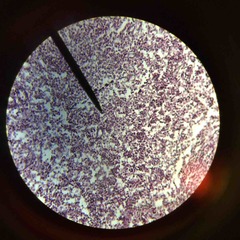
What type of tissue is this? |

Reticular connective tissue. |
|
|
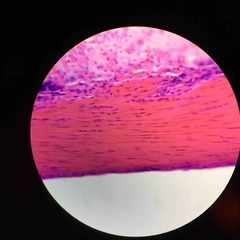
What type of tissue is this? |
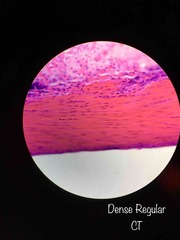
Dense regular collagenous connective tissue. |
|
|
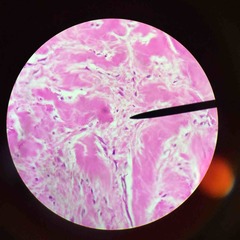
What tissue is this? |
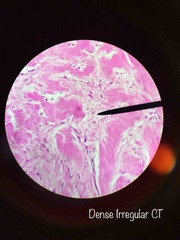
Dense irregular collagenous connective tissue. |
|
|
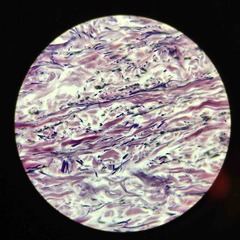
What tissue is this? |
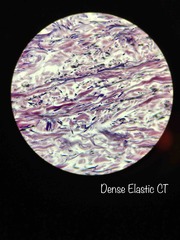
Dense elastic connective tissue. |
|
|

What is this? |
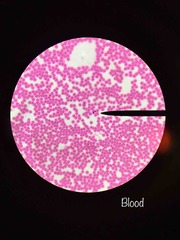
Blood. |
|
|
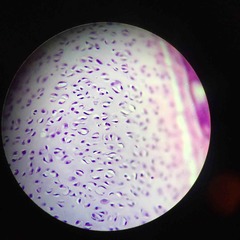
What tissue is this? |
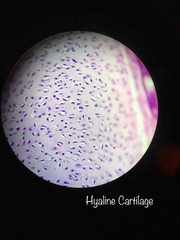
Hyaline cartilage. |
|
|
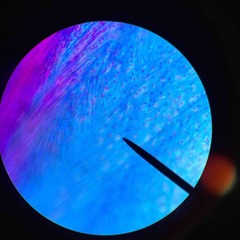
What tissue is this? |
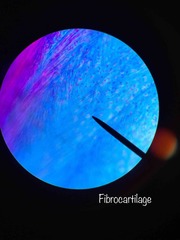
Fibrocartilage. |
|
|
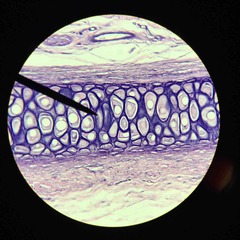
What tissue is this? |
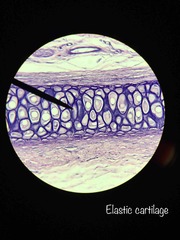
Elastic cartilage. |
|
|
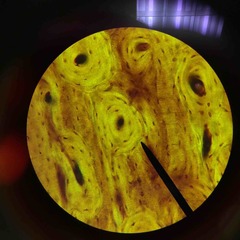
What tissue is this? |
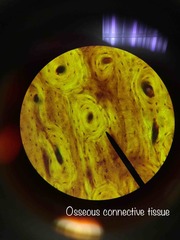
Osseous connective tissue. Bone. |
|
|
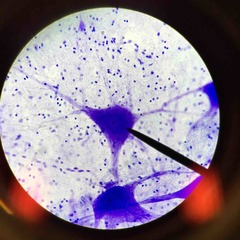
What is this tissue? |

Nervous tissue. |
|
|

What is this? |
Lamellar pacinian corpuscle. |
|
|

What is this? |
Tactile (Meisser’s corpuscle) |
|
|
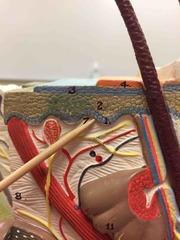
What is this? |
Dermal papillae |
|
|
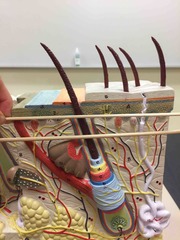
What is the layer in between the sticks? |
Papillary layer. |
|
|
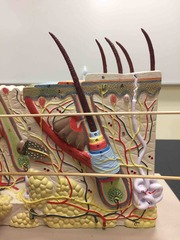
What is the layer in between the sticks? |
Reticular layer. |
|
|

What is this? |
Arrector pili muscles. |
|
|
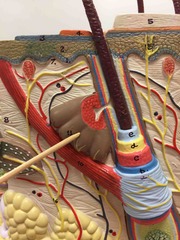
What is this? |
Sebaceous glands. |
|
|

What is this? |
Lamellar (Pacinian) corpuscle. |
|
|
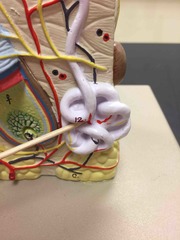
What is this? |
Eccrine (merocrine) sweat gland. |
|
|

What is the layer under the stick. |
The hypodermis. |
|
|
|
What is the function of simple squamous epithelium? |
Allows for quick passage of substances. |
|
|
|
_________ epithelia are found lining the kidney tubules and in the ducts of glands. |
Simple cuboidal. |
|
|
|
Where can you find simple cuboidal epithelium? |
In the lining of the kidneys, in the ducts of glands, in the lining of the thyroid gland, in certain respiratory passages. |
|
|
|
What is the function of simple cuboidal epithelia? |
Secretion/absorption. They are active in the secretion and absorption of molecules. |
|
|
|
What is the function of simple columnar epithelium? |
Absorption/secretion. |
|
|
|
__________ epithelium forms the lining of some sections of the digestive system and parts of the female reproductive tract... Ciliated ________ are found lining fallopian tunes and parts of the respiratory system. |
Simple columnar epithelium. |
|
|
|
Where can you find simple columnar epithelium? |
Lining the digestive system, lining the female reproductive tract, the epiglottis... |
|
|
|
__________ epithelium is found in the respiratory tract, the nasal cavity, trachea, and bronchi. |
Pseudostratified ciliated columnar. |
|
|
|
What is the function of pseudostratified ciliated columnar epithelium? |
Secretes mucus, ciliated tissue moves mucus. |
|
|
|
Where can you find simple squamous epithelium? |
Air sacs of lungs and the longing of the heart, blood vessels, and lymphatic vessels. |
|
|
|
What is the function of simple squamous epithelium? |
Allows materials to pass through by diffusion and filtration, and secretes lubricating substance. |
|
|
|
_______ epithelium’s function is that it absorbs, and it also secretes mucous enzymes. |
Simple columnar epithelium. |
|
|
|
__________ epithelium lines the esophagus, mouth, and vagina. |
Stratified squamous. |
|
|
|
The function of __________ epithelium is to protect against abrasion. |
Stratified squamous. |
|
|
|
What is the function of stratified squamous epithelium? |
To protect against abrasion. |
|
|
|
Where can you find stratified squamous epithelium? |
The esophagus, mouth, and vagina. |
|
|
|
____________ epithelium can be found in sweat glands, salivary glands, and mammary glands. |
Stratified cuboidal. |
“Cute boys...” |
|
|
What is the function of stratified cuboidal epithelium? |
It is a protective tissue. |
|
|
|
Where can you find stratified cuboidal epithelium? |
Sweat glands, salivary glands, and the mammary glands. |
|
|
|
__________ epithelium is a protective tissue. |
Stratified cuboidal. |
|
|
|
___________ epithelium is found in the male urethra and the ducts of some glands. |
Stratified columnar. |
|
|
|
What is the function of stratified columnar epithelium? |
Secretes and protects. |
|
|
|
___________ epithelium is found lining the bladder, urethra, and the ureters. |
Transitional. |
|
|
|
What is the function of transitional epithelium? |
Allows the urinary organs to expand and stretch. Expanding/stretching. |
|
|
|
What is the function of areolar connective tissue? |
It fills spaces between muscle fibers surrounds blood and lymph vessels, and supports organs in the abdominal cavity. Helps “glue” together the tissue layers of the organ. |
|
|
|
_________ connective tissue fills spaces between muscle fibers surrounds blood and lymph vessels, and supports organs in the abdominal cavity. It helps “glue” together the tissue layers of the organ. |
Areolar. |
|
|
|
Where can you find loose areolar connective tissue? |
In the digestive system, respiratory system. Surrounds blood vessels, nerves, and joints. |
|
|
|
What cells and fibers can you find within loose areolar connective tissue? |
Cells: fibroblast. Fibers: collagen fibers and elastic fibers. |
|
|
|
Where is reticular connective tissue located? |
Located in the spleen and lymph nodes. Around blood vessels and nerves. |
|
|
|
Where is reticular connective tissue located? |
Located in the spleen and lymph nodes. Around blood vessels and nerves. |
|
|
|
What cells and fibers are found in reticular connective tissue? |
Cells- reticular cells. Fibers- reticular fibers. |
|
|
|
Where is reticular connective tissue located? |
Located in the spleen and lymph nodes. Around blood vessels and nerves. |
|
|
|
What cells and fibers are found in reticular connective tissue? |
Cells- reticular cells. Fibers- reticular fibers. |
|
|
|
_________ connective tissue is located in the spleen and lymph nodes, around blood vessels and nerves. |
Reticular. |
|
|
|
Where is reticular connective tissue located? |
Located in the spleen and lymph nodes. Around blood vessels and nerves. |
|
|
|
What cells and fibers are found in reticular connective tissue? |
Cells- reticular cells. Fibers- reticular fibers. |
|
|
|
_________ connective tissue is located in the spleen, liver, and lymph nodes, around blood vessels and nerves. |
Reticular. |
|
|
|
What is the function of reticular connective tissue? |
It is a mesh-like supportive framework for soft organs such as lymphatic tissue, the spleen, and the liver. |
|
|
|
_______ tissue can be found protecting the kidneys and cushioning the back of the eye. |
Adipose. |
|
|
|
_______ tissue can be found protecting the kidneys and cushioning the back of the eye. |
Adipose. |
|
|
|
What is the function of adipose tissue? |
Lipid storage, insulation from cold temperatures and mechanical injuries. |
|
|
|
What cells and fibers are found in adipose tissue? |
Cells- adipocytes. Fibers- collagen fibers. |
|
|
|
What is the functions of dense regular connective tissue? |
Tensile strength and resistance to stretching. |
|
|
|
What is the functions of dense regular connective tissue? |
Tensile strength and resistance to stretching. |
|
|
|
Where is dense connective tissue located? |
Ligaments and tendons. |
|

